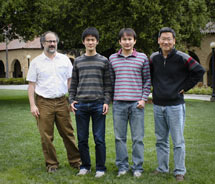
Handy Links
SLAC News Center
SLAC Today
- Subscribe
- Archives: Feb 2006-May 20, 2011
- Archives: May 23, 2011 and later
- Submit Feedback or Story Ideas
- About SLAC Today
SLAC News
Lab News
- Interactions
- Lightsources.org
- ILC NewsLine
- Int'l Science Grid This Week
- Fermilab Today
- Berkeley Lab News
- @brookhaven TODAY
- DOE Pulse
- CERN Courier
- DESY inForm
- US / LHC
SLAC Links
- Emergency
- Safety
- Policy Repository
- Site Entry Form

- Site Maps
- M & O Review
- Computing Status & Calendar
- SLAC Colloquium
- SLACspeak
- SLACspace
- SLAC Logo
- Café Menu
- Flea Market
- Web E-mail
- Marguerite Shuttle
- Discount Commuter Passes
-
Award Reporting Form
- SPIRES
- SciDoc
- Activity Groups
- Library
Stanford
Around the Bay
To Surf, or to Dance? Electrons' Extracurricular Activities Affect Superconductivity
Superconductors, the wonder materials that transport electricity without any resistance or energy loss, appear to be more complex than previously thought, according to research published online this week in Nature Physics by scientists at the Stanford Institute for Materials and Energy Science, a joint institute of SLAC National Accelerator Laboratory and Stanford University. The work provides a new understanding of how high-temperature superconductors work—with potential applications toward the design of new superconductors that work at or near room temperature, allowing them to be used in everything from electronics to smart grids that deliver energy with dramatically higher efficiency.
This is not the first time the field of superconductivity has gone through a revelation. In the 1980s—75 years after the discovery of superconductivity—scientists stumbled upon a completely new type of superconducting material. Previously, all superconductors carried current without resistance only at very low temperatures, the warmest of them operating at about -425 degrees Fahrenheit. But this new class of superconducting materials mysteriously worked up to 200 degrees warmer; still not room temperature, but far warmer than researchers previously believed possible.
"High-temperature superconductivity is one of the most important unsolved modern physics problems today," said SIMES Director and paper co-author Zhi-Xun Shen.
When a conventional superconductor reaches a critical temperature, called Tc, electrons begin to overcome their preference to mutually repel one another, and instead begin to bunch in pairs that like to cooperate with other pairs. When these linked electron duos liaise to form "coherent motion," with all pairs moving in synch much as couples dance to the same music at a ball, they flow through a material effortlessly. Scientists first understood this by detecting a gap in the electron's energy spectrum that reflects the benefit of the electrons' pairing.
A decade ago, scientists discovered an analogous "pseudogap" in high-temperature superconductors, at temperatures above the superconducting threshold Tc, that was originally thought to also be related to electron pairing. In this gap, scientists theorized, the pairs are formed but they lie dormant; the couples are ready but music has yet to begin.
Yet experiments led by SIMES researchers Makoto Hashimoto and Rui-Hua He suggest that the electron-pairing model does not describe what happens in the newer high-temperature superconductors.
"In 2006, our group published a paper suggesting that there are two types of distinct energy gaps," He said. "This more recent work provides a conclusive argument that there are two different mechanisms involved here."
The researchers trained the X-ray beam of SLAC's Stanford Synchrotron Radiation Lightsource on a high-temperature superconductor to reveal the material's electronic structure and explore the nature of the pseudogap. They were on a hunt for evidence of the electron pairing seen in conventional superconductors, in the form of what's called "electron-hole symmetry"; if it were present in the pseudogap, then the road to designing even higher temperature superconductors would be to make the pairs dance together instead of resting dormant.
But that's not what the researchers found; under the bright X-ray beam, the high-temperature superconductor showed a clear lack of the telltale symmetry—and thus of electron pairing. This suggests that the electron pairs were not lying dormant; they were simply not there.
The researchers posit that the electrons do not pair in this temperature range and instead travel in a wave; what they observed at SSRL were crests and troughs of electron density. The electrons' tendency to travel in a density wave may compete with their efforts to pair, suggesting that scientists will need a different approach in order to create a room-temperature superconductor.
"This is a very difficult problem, but an important one to solve," said Hashimoto. "We don't yet know the details of the density wave, but by extending our studies to different materials we are now seeking to understand it."
Once researchers better understand how electrons travel in high-temperature superconductors, they can then begin trying to design materials that superconduct at even higher temperatures. So far, high-temperature superconductors have been found only through serendipity. A robust understanding of how electrons travel at high temperatures may allow researchers to design new superconductors from the ground up, pinpointing the most useful temperature range for each application.
"If we can figure out the elusive recipe for making a superconductor," said SIMES Co-deputy Director and paper co-author Tom Devereaux, "we can begin designing them for important applications in human health, communication, and energy transportation as well as accelerator technology."
—Kelen Tuttle
SLAC Today, April 6, 2010
